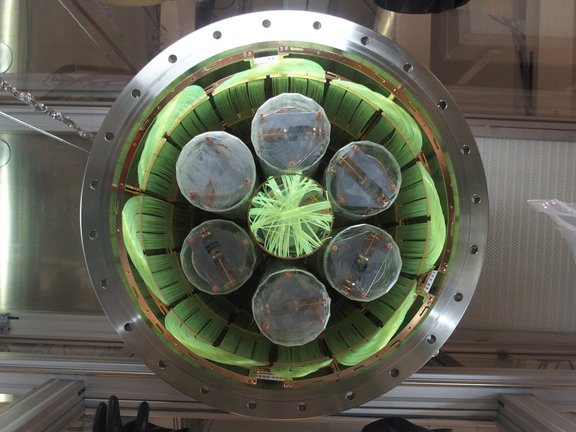The neutrino puzzles
Neutrino oscillation has been the first established experimental observation not consistent with predictions of the Standard Model of Particle Physics: The three known neutrino types can transform into each other while traveling through space – which proves that neutrinos have non-zero masses (Nobel Prize 2015), a property that contradicts the Standard Model.
Additionally, there is the longstanding conjecture that neutrinos are so-called Majorana particles: differing from all other constituents of matter like electrons or quarks they could be their own antiparticles. In this case, neutrinoless double beta decay will exist, in which matter is created without the balancing creation of antimatter. This imbalance would help to explain why there is so much more matter than antimatter in the Universe.
The GERDA experiment located in the Gran Sasso underground laboratory (LNGS) in Italy is designed to scrutinize the Majorana hypothesis by searching for neutrinoless double beta decay of the germanium isotope 76Ge: two neutrons inside a 76Ge nucleus simultaneously transform into two protons with the emission of two electrons. This decay is forbidden in the Standard Model because the two normally produced antineutrinos – the balancing antimatter – are missing.
A (nearly) background-free experiment
The sensitivity to detect neutrinoless double beta decay largely depends on the level of interfering signals from environmental radioactivity. GERDA has reached the lowest level of those by shielding with pure water and liquid argon and additional methods to reject the remaining interfering signals. It is now the first experiment that has surpassed a sensitivity for the half-life of this decay of 1026 years, or in other words, has proven that the process has a half-life of at least 1026 years, 16 orders of magnitude longer than the age of the universe. This half-life limit corresponds to a rate of less than 1 decay per 18 years for 1 kg of 76Ge.
Implications on the neutrino mass
In the standard interpretation of neutrinoless double beta decay, the half-life is related to a special variant of the neutrino mass called the Majorana mass. Using the GERDA limit and the ones from other double beta decay experiments, this mass has to be below 0.07-0.16 eV/c2. A limit on another parameter is available from the Planck collaboration investigating the cosmic microwave background radiation – the relic of the big bang: the sum of the masses of all known neutrino types is below 0,12-0,66 eV/c2. The tritium decay experiment KATRIN at the Karlsruhe Institute of Technology (KIT) will be measuring in the upcoming years yet another variant, the electron neutrino mass. KATRIN will reach a sensitivity of about 0,2 eV/c2. The masses deduced from these different investigations cannot be compared directly but, most interestingly, allow a cross check of the paradigm that neutrinos are Majorana neutrinos. So far, no tension has been observed.
From GERDA to LEGEND
During the reported data collection period, GERDA operated germanium detectors with a total mass of 35.6 kg. The fraction of the isotope 76Ge has been enriched from the natural abundance of 7.8% to more than 85% to increase the half-life sensitivity. As the next step, the mass will be increased and an even further reduction of interfering signals is required. The latter will be achieved by improving the identification of these signals and by further reducing the radioactivity of material close to the germanium detector. The LEGEND collaboration has formed to pursue this goal starting with 200 kg of 76Ge and using the existing GERDA infrastructure at LNGS. The sensitivity will reach 1027 years after about 5 years starting in 2021.
The Max Planck Institute for Nuclear Physics was among the initiators of the GERDA project and contributed significantly to the construction of the experiment. Members of the divisions of Werner Hofmann and Manfred Lindner handled the refurbishment or purchase of the germanium detectors as well as the construction of the liquid-argon cryostat. MPIK’s expertise in the detection of extremely low traces of radioactivity played a crucial role for material selection, which is essential for background suppression. Further, the light instrumentation for identification of interfering signals was developed at the MPIK. And last but not least, the MPIK scientists are involved in data taking and analysis.
Original publication:
Probing Majorana neutrinos with double-β decay, GERDA Collaboration, Science online 5. September 2019, doi: 10.1126/science.aav8613
Setup of the GERDA experiment (animation)
